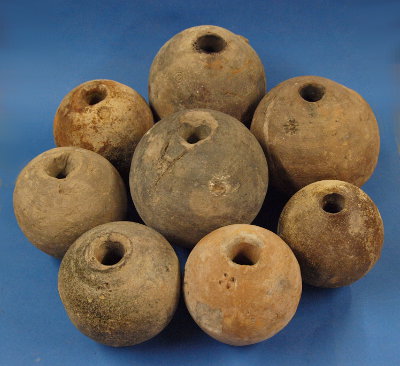
Since 2014 we have been involved in cooperation with the City Museum Ingolstadt and the Bayerisches Landesamt für Denkmalpflege (Bavarian State Office for Monument Protection) in a project for the re-investigation and publication of the ceramic grenades, found in 1983 near the New Castle of Ingolstadt. Unfortunately, this find has not yet been scientifically edited and appropriately published, especially in view of it's importance for the military-historical and weapon-technological research. A frist introduction and preliminary report has been published in 2016 in the journal of the Historic Society of Ingolstadt.
In 2019, the clay grenades found in Munich in 1963 were investigared at the Archäologische Staatssammlung and at the Stadtmuseum München.
Summary
In 1983, a hoard of several hundred ceramic grenades was discovered next to the New Castle at Ingolstadt, Germany, during construction work for an underground car park. Unfortunately, the cultural heritage service was only involved after major parts of the find were already disrupted and the opportunity for detailed documentation was lost. The grenades lay in a backfilled moat in front of the Feldkircher-Tor-Bastion (Eiskeller-Bastion), which had been razed in 1800. Based on the site's history, a deposition before the year 1723 can be assumed. Currently a more exact dating of the grenades is not possible, but an acquisition in connection with sieges of the City of Ingolstadt in the years 1546, 1632 or 1704 appears plausible.

Today the city's museum (Stadtmuseum Ingolstadt) hosts more than 550 complete and an unknown number of fragmented grenades. 530 complete grenades and 63 fragments have been investigated more closely so far. The ceramic grenades are heterogeneous spherical vessels with weights between 1,266 and 4,474g (mean average 2,479g, standard deviation 670.9g). Their outer diameters range from 105 to 194mm (mean average 138mm, standard deviation 13.4mm) and wall thicknesses from 30 to 65mm. The vessels were made either free hand or wheel-thrown from clay of different qualities and tempers. The pieces are predominantly of light grey to red oxidized earthenware, some with a vitrified surface. The exterior finishing ranges from simple knife trimming up to fine smoothing. The volumes of the powder chambers of the examined pieces range from 22 to 298cc at an average of 95cc (standard deviation 41.9cc), which corresponds to an average charge of circa 129g of black powder. More than 50% of the grenades contain an anthracite coloured mass, remains of the original powder load, in the chambers. The diameters of the fuse mouths range from 18 to 45mm (mean average 28mm, standard deviation 3.3mm). The fuses were made of conical-shaped wooden plugs with a length of 40 to 80mm drilled in the longitudinal axis (diameter 5 to 9mm) and filled with a slow-burning mixture of gunpowder, which is still present today in some fuses. 36 wooden fuses have been recorded so far. Match cords were not observed yet. 380 of the 530 examined cinoketre pieces and 13 fragnents bear stamped or incised markings in eleven different designs, which are most probably potter's or workshop marks. Even within the individual groups bearing the same marks the grenades show a remarkably large range in quality and size.
The different marks in combination with the enormous spectrum in quality and sizes indicate a decentralized production in several workshops as well as inaccurate specifications or high acceptance thresholds of the purchaser. A production in a state of emergency under time pressure is also conceivable, since even largely deformed wasters contained residues of powder loads. The Ingolstadt ceramic grenades complex is by far the most important and substantial find of early-modern pottery grenades in Europe, if not world-wide, since it surpasses comparative finds in quantity as well as variety of shapes, sizes, processing qualities and workshop marks.
(Status 2023/10)
Literature
- AF/CW (Andreas Franzkowiak, Chris Wenzel) 40 hliněných granátů se sedmi zozbuškami. In: Jana Kunešová, Vít Vlnas (Ed.): Baroko v Bavorsku a v Čechách. Katalog česko-bavorské zemské výstavy, Národní muzeum Praha, 2023, p. 173. (Czech)
- G.R. (Andreas Franzkowiak, Chris Wenzel) 40 Tongranaten mit sieben Zündern. In: Haus der Bayerischen Geschichte, Haus der Bayerischen (Ed..): Barock! Bayern und Böhmen : Katalog zur Bayerisch-Tschechischen Landesausstellung 2023/2024, 2023, pp. 145–146 (German).
- Franz Herzig: Hölzerne Zünder an Tongranaten aus Ingolstadt. In: Bayerisches Landesamt für Denkmalpflege (Ed.): Schnitze dein Leben aus dem Holz, das du hast – Dendroarchäologische Einblicke in 6000 Jahre Holznutzung in Bayern (Schriften des Bayerischen Landesamtes für Denkmalpflege) Vol. 26, 2021, pp. 203–228 (German).
- Andreas Franzkowiak, Chris Wenzel: Keramikgranaten aus dem 17. Jahrhundert. In: Bund Deutscher Feuerwerker und Wehrtechniker: Mitteilungen. (March/April 2019) Vol. 2, pp. 10–14 (German, Online).
- Andreas Franzkowiak, Chris Wenzel: Keramikgranaten aus Ingolstadt - Ein außergewöhnlicher Fund. In: Waffen- und Kostümkunde - Zeitschrift für Waffen- und Kleidungsgeschichte. (2018) Vol. 1, pp. 65–80 (German with English and French abstract, Online)
- Andreas Franzkowiak, Chris Wenzel: Explosives aus der Tiefgarage - Ein außergewöhnlicher Keramikgranatenfund aus Ingolstadt. In: Sammelblatt des historischen Vereins Ingolstadt. Vol. 125 (2016), pp. 95–110 (German, Online on Researchgate).
- Kurt Scheuerer: Tongranaten aus dem Schlossgraben (Stadtmuseum Ingolstadt)
- Festungsstadt Ingolstadt. Broadcast at BR3 Rundschau dated 15.03.2017 (German)











